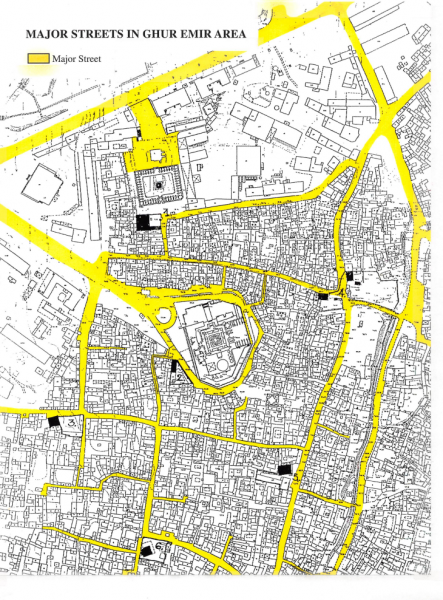Abstract
In 1994, the Unit for Housing and Urbanization implemented an urban revitalization strategy for the rehabilitation of the historic urban fabric in Samarkand, Uzbekistan.
Through the Technical Assistance project the Unit aimed to assist local government authorities to adopt improvement strategies. The Unit worked with local public officials, practitioners, and Mahalla leaders to establish an institutional framework for local revitalization and rehabilitation initiatives within the city’s Ghur Emir historic district. Documents include the Full Report, “Institutional Framework to Foster Revitalization and Local Rehabilitation Initiatives” as well as Color Maps and Color Photographs.
Excerpt
[Excerpt, Full Report, August 1994]
“This report presents the findings of a mission to Samarkand undertaken by Mona Serageldin adjunct professor of Urban Planning and Associate Director of the Unit for Housing and Urbanization at Harvard University Graduate School of Design in June 15-22, 1996. The Mission was sponsored by the Aga Khan Trust of Culture, Historic Cities Support Program, for the purpose of assisting the government authorities in Samarkand and the AKTC in establishing an institutional framework to foster revitalization and local rehabilitation initiatives in the city’s Historic District. The support received from Dr. Stephano Bianca, Director of the Historic Cities Support Program, Mr. Nemetjon Sadiqov, AKTC representative in Samarkand and their staff contributed to the successful completion of the mission.”

See related I2UD projects below
| Project Year: | 1994 |
| Project Type: | Local Rehabilitation Initiative and Technical Assistance |
| Geographic Regions: | Samarkand, Uzbekistan |
| Reports: | City of Samarkand: Full Report (August 1996) City of Samarkand: (Color Maps) City of Samarkand: (Color Photographs) |
| Authors: | Mona Serageldin; Boguslaw Trondowski; Sameh Wahba; Anna Zietek |
| Sponsors: | Aga Khan Trust for Culture, Historic Cities Programme |
| Categories: | Historic Districts |
| ID: | 1994_00_003 |
Related I2UD Projects
Related by – Historic District Preservation
Design Studio 1981: “Housing Design in Islamic Cultures” in Algeria, Bangladesh, Egypt, Iraq, Pakistan, Saudi Arabia and Indonesia, Seminar Curriculum
“Economy of Historic Preservation” in Erbil, Kurdistan, Report for Strengthening Urban & Regional Planning (SURP), UN-HABITAT, 2014
“Comprehensive Plan for Makkah, Madinah and Mashaer,” Urban Development Strategy for Ancient Holy Sites in Saudi Arabia, 2009
“Sustainable Development Based on Valorizing the Historic Urban Fabric,” Paper by Dr. Mona Serageldin, 9th World Congress of the Organization of World Heritage Cities in Kazan, Tatarstan, Russia, 2007
“Integrated Area Management Action Plan,” Urban Management Plan for the Ancient Walled City Icheri Sheher, Baku, Azerbaijan, 2006
“Revitalization of Kars Historic Center” & “Strategies for Sustainable Development,” Technical Assistance and Capacity-Building for Kars, Turkey, 2004-2008
“Cooperation and Capacity Building for Promoting Cultural, Natural and Built Heritage in Transylvania,” Technical Assistance Report for Brașov, Sibiu, Sighișoara and Târgu Mureș, Romania, 2004
“Continuity and Change” by Dr. Mona Serageldin, Topic Paper for 48th World Congress, International Federation for Housing and Planning (IFHP), 2004
“Historic Center of Mexico City” Diagnostic Summary, Technical Assistance for Mexico City, Mexico, 2003
“Master Plan for the Revitalization of the Older Urban Fabric,” Preservation in the Old City of Al Qusair, Egypt, 2000
“St. Petersburg Center City Rehabilitation Project,” Urban Planning Network for St. Petersburg, Russia, 2000
“Preserving the Historic Urban Fabric in a Context of Fast Paced Change,” Research Essay by Dr. Mona Serageldin, 1998
“Lublin Local Initiatives Program” & “Lublin Old Town Rehabilitation Project,” Technical Assistance for Urban Upgrading in Lublin, Poland, 1994-2000
“Samarkand, Uzbekistan: Revitalization and Rehabilitation of the Historic District,” Technical Assistance for the City of Samarkand, Uzbekistan, 1994
“Upgrading and Conservation of the Walled City of Lahore,” Regional Report on the Preservation of Historic Lahore, Pakistan, 1988

